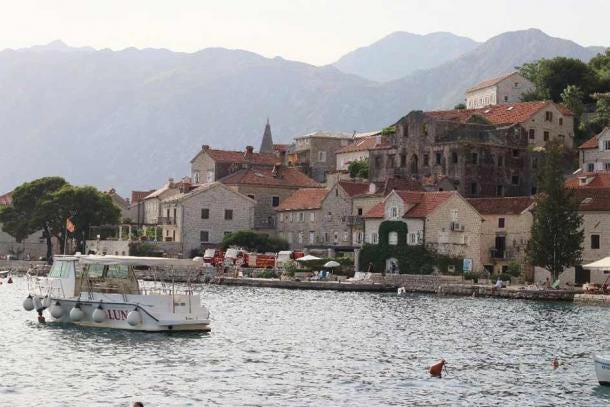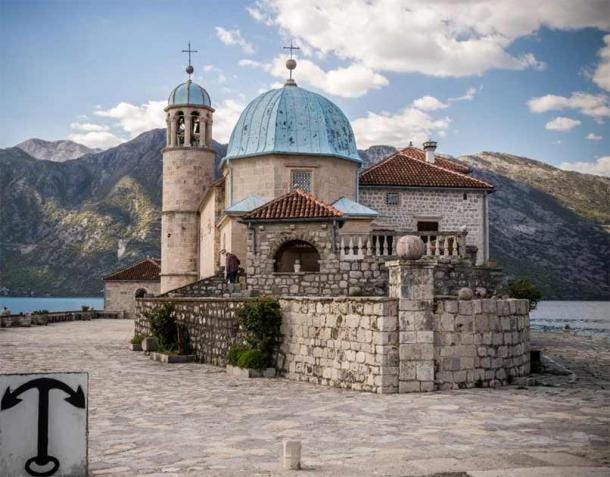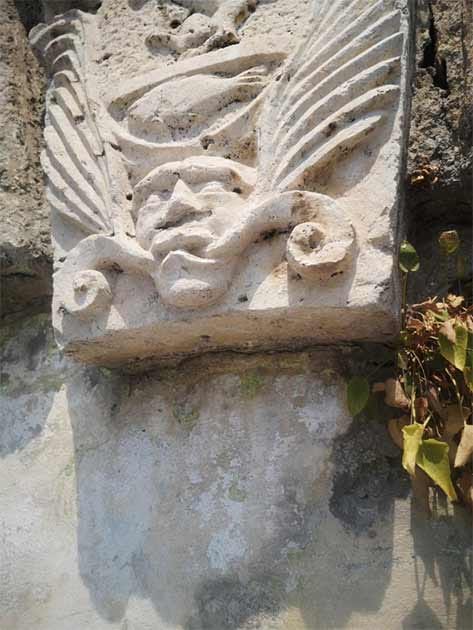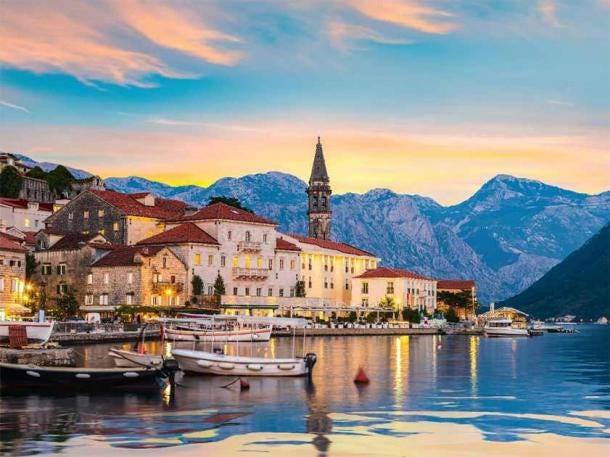This is the first I have ever heard of this port town and it was certainly important to a marine power such as Venice. This reminds us that marine powers need friendly ports to properly extend and protect their naval force.
Historians should actually map these semi alliances and measure their economic impact.
The late British empire was diligently setting up coaling stations all over the world. This made it almost impossible for anyone else to do a thing.
.
A Tiny Town with an Enormous History: Perast, The Pearl of Boka
Sep 12
Montenegro’s illustrious Bay of Kotor is a maritime region filled with unique places that boast a long and far-reaching history. Amongst the numerous historic cities that dot the bay’s shores, Perast stands out as one of the oldest and most attractive amongst them. And, of course, its history is brimming with unique tales, figures, and achievements. We will touch upon all the important sites of the Bay of Kotor, and the first stop on the journey is that small seaside port of Perast. Once a powerful and prominent trading port that continually strove for great achievements under the wings of the Venetian Republic, the Perast of today is a tourist hotspot for lovers of history and perfect summer relaxation!
Perast seaside. (Aleksa Vučković)
From a Fishing Village to a Rich Shipbuilding Port: Origins of Perast
This charming little historic town is located in a very important strategic position. On a larger scale, it is situated within the Bay of Kotor, known locally as Boka, a bay that dominates the maritime area of South Montenegro. Historically, it is the southernmost part of the region of Dalmatia.
Of all the cities and trading ports within this large bay, Perast is arguably situated at the most important spot. It is nestled at the bottom of the steeply rising hill of St. Elijah (873 meters (2864.17 ft.) tall), and almost directly on the water. Straight ahead of it, in the distance, is the strategically crucial narrow strait known as Verige (Chains), or Stretto di Catene in Italian. The strait is the narrowest in the Bay of Kotor, and thus one of the most vulnerable spots, both for the interior of the bay and for the passing trade ships.
Of all the cities and trading ports within the large bay, Perast is arguably situated at the most important spot. (Aleksa Vučković)
The strait’s name, Verige, translates as Chains, and this is due to the protective naval chain that was employed for centuries by the seafarers of Perast. This massive chain would be straightened in times of crisis, and would block all enemy ships wanting to either enter the interior of the bay, or flee it. The city that controlled and commanded these chains would likewise obtain power within the bay.
Human habitation on the site of Perast reaches far back in time. Archaeological excavations, both within the city and the caves above it, yielded substantial results. One of the caves, Spila ( Шпила), yielded evidence of prehistoric habitation in the area. The earliest credible information, however, is dated to classical antiquity, and the many Illyrian tribes that lived on the shores of the Adriatic.
Local stories cling to the theory that the name Perast stems from the name of a historically documented Illyrian tribe of Pirustae (Πειρουσται) . These are first mentioned by the Roman historian Titus Livius in connection to the end of the Third Macedon War of 167 BC. In his work, he dubs the Pirustai as “civitas libera et immunis”, i.e., free citizens who are freed from taxation. The root of the name is Greek “Piros”, meaning “fire”. Alas, it is likely that the city of Perast has no connection to this ancient tribe. The actual Pirustae are attested as living much further to the north.
An Ambience that Leaves You Breathless
Those seeking to fully experience the rich history of the Kotor Bay would make no mistake in visiting Perast and immersing themselves in its utterly captivating medieval ambience. In comparison with the other historic cities of the area, Perast is not marred by any modern construction, apartment blocks, neon signs, or commercial stores. Simply put, it is a tiny seaside port town that prides itself on the centuries of maritime history - and it has remained largely unchanged over the centuries. After all, due to its position - it is perched right on the seaside - it is somewhat protected from any potential new building: there simply is no place to construct any further.
The regional road passes well above the little town - you can enter only by foot. Historically, the road above did not exist, and the most common mode of transportation for the citizens of Perast was the boat. Of course, this had plenty to do with preserving its strategic position and the ability to effectively protect itself from roughly three sides: it was open only to the sea.
And likewise, the town of Perast and all its proud inhabitants gazed only outwards towards that deep blue sea and the wonders it kept. For centuries and countless generations, the citizens of Perast were proud seafarers, maritime merchants and world-voyagers. It is this maritime history that fully shaped the character of the town.
Historically the most common mode of transportation for the citizens of Perast was the boat. (Aleksa Vučković)
Perast acquired its final architectural layout during the 17th and 18th centuries, and has remained largely unchanged ever since. Nowadays, it continues to be one of the most attractive examples of the rich and streamlined baroque style of building that was prevalent on the coasts of the Adriatic Sea. Of course, the city did have to struggle through the ever-shifting turbulent epochs of the region, but its historic core still managed to persevere and survive. Even so, its charm is undeniable.
Whether approaching it from the sea or by road, you are always greeted by its charming red rooftops and baroque Venetian-style houses jutting outwards and seemingly touching the inky-blue waters of the Boka. Like most of the towns and hamlets in the Bay of Kotor, Perast too is built up densely. The town has no streets - at least not in the usual sense. The houses are all jumbled together, one beside the other, touching wall to wall. The few streets are tiny, stepped, narrow, and steep - all leading upwards, as the houses were built upon the slight rise of the hill.
On a street in Perast. (Aleksa Vučković)
The Sea, the Sky, and the Palazzos of Perast
Arguably, Perast has no ugly houses. Each one is aged and possesses that undeniable medieval charm. Every house is built from pearly white stone, which creates a striking contrast with the weather-beaten red roofs. To break up this unique panorama, several towers jut out towards the skies, dominating the heights of the town.
The chief of these is unmistakably the fifty-five meter (180.45 ft.) tall bell tower of the lavish church of St. Nicholas. Both are situated at the very center of the town, on the so-called piazza - the town square. The tower was designed by the Venetian deacon Giovanni Scarpe and completed in 1691, while the church - although never fully completed - was built by architect Giuseppe Beati in the decades before that.
Narrow medieval streets. (Aleksa Vučković)
High above the city, in the forested hillside, stand the remains of the Fortress of the Holy Cross. Since the seaside port town had no city walls for protection, the fortress was needed. Following repeated pirate attacks, the fortress was constructed in 1570. Together with the imposing view over the bay and the well-placed cannons, it provided ample protection for the town below. The locals know it as Forteca ( Fortezza).
Perast prides itself on its fourteen remarkable little churches. In larger cities, this number wouldn’t be anything out of the ordinary. However, considering the tiny size of Perast, fourteen churches is indeed a whole lot. Still, they are so skillfully merged into the other buildings that it is easy to miss them if one is not paying attention.
Besides the enormous church of St. Nicholas on the main square, we should mention the church of “Lady of Rosary”, dominated by its rich octagonal bell tower. It was constructed by the baroque poet and archbishop Andrija Zmajević, in 1678. There is also the church of Saint Mark, built in 1760, as well as a younger church of Saint Anthony, dated to 1679. Besides these, there are the churches of Saint Anne, John the Baptist, and others. The oldest church in Perast dates to the 9th century - the Church of the Holy Cross. It is also the tiniest, with room for only a single occupant, and decorated with nothing more than a large cross.
Church of Our Lady of the Rocks, Perast, Montenegro. ( radzonimo / Adobe Stock)
The city of Perast is unique for its several prominent noble houses - better described as brotherhoods . They were known as kazade (Italian: Casada), and yielded many influential seafaring families of the city. There were twelve noble houses in total, and the number was always the same. These were: Studeni, Dentali, Vukašević, Rajković, Šilopi, Šestokrilović, Bratica, Stoišić, Smilojević, Čizmai, Perojević, Mioković.
These houses often rivaled and competed with one another, and they built their wealth and influence on achievements at sea. Of course, the families with more ships and better trade routes were quicker to ascend to prominence.
Seafaring Captains and a Rich Maritime Heritage
Of course, the wealth of these families is undeniably what gave Perast the charming character it has today. This is due to the numerous noble palaces that dot the town. Each family would erect a lofty stone palazzo of the Venetian baroque style, many of them several stories tall. Each one is adorned with the appropriate family coat of arms, alongside many iconic balustrades, terraces, stone carvings, and other details that quickly draw the eye.
Arguably the richest and prettiest of all these palaces is the one that was created in 1694 for the famed Conte Vicko (Vincenzo) Bujović, one of Perast’s most interesting figures. It was designed and built by a renowned Venetian architect, Giovanni Battista Fonta . This luxurious palace is accentuated by its unique jutting portico of the Venetian bugnatto style. It gives the impression that the palace is virtually on the sea. Today, the palace houses the Museum of Perast.
Carved detailing on one of the buildings. (Aleksa Vučković)
However, the largest extant palace in Perast - and also one of the richest - was built by the influential Smecchia (Smekja) family. They rose to immense wealth and prominence when Conte Petro Smecchia, with his ship Leon Coronato , established a trading route between Venice and the Baltic nations in 1746. It is characterized by its two large balconies, balustrades, and a unique double-palace style.
The entirety of Perast’s medieval and baroque wealth and prominence is directly tied not only to its strategic position in the Bay of Kotor, but also to the intensive sea voyaging and trade, as well as many privileges the city acquired over time. Although an old seaside port has been documented in the early Middle Ages, Perast only began rising in prominence in the 1400’s. Before this, it was a part of the Serbian medieval kingdom, and later empire, from 1186 until 1371. However, with the latter’s defeat at the hands of the invading Ottomans, Perast acquired a semblance of semi-independence.
But not long after, in 1420, Perast came under the rule and protection of a new, powerful sovereign - the Republic of Venice. Over the following centuries, Perast would remain a fiercely loyal servant and ally of this huge maritime power. And for that very reason, the city would continue to receive privileges and to rise in wealth. Very early on, Perast was proclaimed as the esteemed “Keeper of the Venetian war flag” ( Gonfalone di San Marco) . This was a highly important position. Each of the twelve Perastian noble houses would provide a single man to act as a royal standard bearer.
The Jewel That Kept its Shine
Achievements only followed one another in the following centuries. The citizens, alongside prominent Perastian sea-captains, defended not only their city, but also the key strategic entrance into the inner Bay of Kotor. They fought on the Venetian side in several of its conflicts and wars, and were instrumental in defending its properties from the incursions of Ottoman and North African pirates. On the other hand, these captains voyaged far and wide across the world’s seas and oceans, excelling in trade and amazing wealth - generation after generation.
Perast, Montenegro. ( Givaga /Adobe Stock)
Perast is a tiny town with an enormous history. And, as all historic tales go, this one too is filled to the brim with exciting events and colorful noble characters. Writing about all of them is a task to be taken patiently, step by step. And that means that you are yet to read of this historic place - and some noble seafarers whose life stories belong on the pages of some page-turning bestselling novel!
Top image: Perast, Montenegro. Source: Givaga /Adobe Stock
By Aleksa Vučković
References
Martinović, J. J. 2014. Dvanaest Peraških “Kazada”. Hrvatski Glasnik.
Kalicanin, K. 2017. Perast - Tiny Charming City of the Montenegrin Coast. Itinari. [Online] Available at:
Kampe, L. 2016. Grbovi Peraških Kazada. Ocilo.
Information from the Museum of Perast.









No comments:
Post a Comment